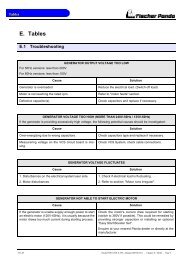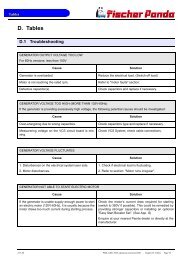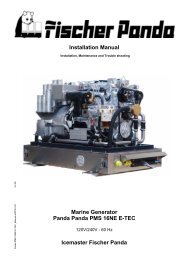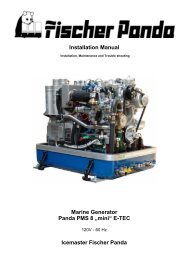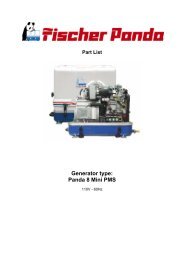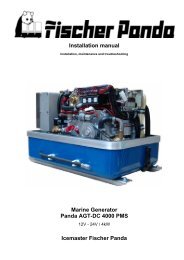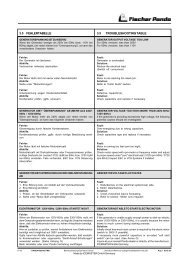Manual
Manual
Manual
Create successful ePaper yourself
Turn your PDF publications into a flip-book with our unique Google optimized e-Paper software.
Generator Failure<br />
(notes: the voltage results from the remainder magnetism of the rotor, which induced a voltage in the coil.)<br />
7.6.2 Measuring the coil resistance<br />
For this a measuring instrument must be used that is suitable for low impedance values.<br />
• Adjust the measuring instrument to resistance test. If hold the poles of the measuring instrument hold together, 0.00<br />
ohms should be indicated. If the poles are isolated, the display should indicate an overflow. Please implement this<br />
test, in order to examine the equipment.<br />
• Measure of the resistance within the individual windings.<br />
If strong deviations in the individual coils are measured, must assumed that there is a coil short-circuit in a coil. This<br />
leads to the fact that the generator does not excite itself any longer.<br />
The actual values between the coils and ground are not to be determined exactly. It depends primarily on the fact<br />
that the values of all three measurements are close to the same. Deviations among themselves refer to a coil shortcircuit.<br />
In this case the generator must be wound again by a specialist.<br />
7.6.3 Checking the coil(s) to short-circuit<br />
In order to check the coils for short-circuit, first all lines, which lead to the electrical system, must be interrupted. This<br />
happens on the power terminal box of the generator or, if available, in the electrical system junction box. Guarantee<br />
that no voltage lies at the lines, before they are interrupted (see “Testing generator stator windings” on Page 122.).<br />
Now remove the bridge between „N“ and „PE“, so that coils and housing are electrically separate from each other.<br />
Check with a circuit indicator (multimeter) in the power terminal box if between the individual connection points of the<br />
coil and the housing (PE) a pass exists.<br />
The contacts which can be measured depend on the type of the<br />
generator (see identification plate):<br />
HP1 - 50Hz: L, Z<br />
HP1 - 60Hz: L, Z<br />
HP3 - 50Hz: L1, L2, L3<br />
HP3 - 60Hz: L1, L2, L3, 1, 2, 3, 4<br />
DVS - 50Hz: L1, L2, L3, L1’<br />
DVS - 60Hz: L1, L2, L3, L1’, 1, 2, 3, 4<br />
Fig. 7.6.3-1: Type plate<br />
If a pass (beep) should be determined, the generator must be returned for examination in the plant, or it can also be<br />
wound again locally. For this coil data can be requested.<br />
7.6.4 Measuring the inductive resistance<br />
Unfortunately the checking of the ohmic resistance permits still no reliable statement about the condition of the coil.<br />
If the ohmic resistance values arise inequalities between the coils, that is a safe indication for the fact that the coil is<br />
defective. To be exactly sure the inductive resistance of the coil have to be measured. For this a special measuring<br />
instrument is necessary, which measures the inductance of a coil.<br />
7.5.12 Panda_4000s_PMS_SCB_FCB_eng.R04 - Kapitel/Chapter 7: Generator Failure Seite/Page 123



